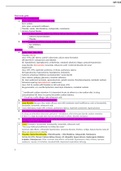NR 508
Final study guide
Cardiovascular management:
1. Know Initial treatment choices for HTN
AceI- sartans
Arbs- ipine, verapamil & diltazem
Thiazide- iaside, chlorthalidone, imdapamide, metolazone
calcium channel blocker
2. Know first line treatment options for HTN for African Americans without renal impairment.
Calcium channel blockers
Thiazide
3. First line option for HTN for anyone with chronic kidney disease
Ace inhibitors
ARB’s
Diuretics:
4. Types, Uses, Side effects
Thiazides (HCTZ)
Uses- HTN, CHF, edema, useful in decreases calcium stone formation
Off label HCTZ- osteoporosis and diabetes
AE- hypokalemia, hyperglycemia, arrhythmias, metabolic alkalosis, fatigue, postural Hypotension
Loop diuretics (furosemide, torsemide, ethacrynic acid) *preferred diuretics for renal
Impairment
Uses- CFH, HTN, nephrotic syndrome, cirrhosis, pulmonary edema
AE-hypocalcemia, hyponatremia, hypokalemia, ototoxicity
Carbonic anhydrase inhibitors (acetazolamide) *weak diuretic
Uses- edema, epilepsy, glaucoma, mountain sickeness
AE- toxic epidermal necrolysis, agranulocytosis, aplastic anemia, thrombocytopenia, metabolic acidosis
Potassium-sparing (spironolactone, eplerenone)
Uses- CHF (in combo with thiazides or ACE and loop), HTN
AE-gynomastia, n/v, erectile dysfuction, electrolyte imbalance, metabolic acidosis
**postdiuretic sodium retention- It is important for pts to adhere to a low sodium diet. As drug
concentrations fall, there is a period of positive sodium balance
** If a pt has a sulfa allergy= take ethacrynic acid
5. Preferred diuretic with renal impairment-
Loop diuretics because they retain efficacy even with moderate renal insufficiency: such as furosemide,
buetanide, torsemide, ethacrynic acid.
Uses: Edematous states (HF, cirrhosis, pulmonary edema, nephrotic syndrome), hypercalcemia
6. Side effect of post diuretic sodium retention pg 374
As drug concentrations decrease, period of + Na balance, this is the post diuretic sodium retention
If there is a high Na intake then Na lost with diuresis is offset.. diuretic resistance
7. Recognition that some diuretics are sulfa derivatives (carbonic anhydrase inhibitors, loop diuretics,
thiazides, but NOT ethacrynic acid)
Loops- Examples: furosemide, bumetanide, torsemide, ethacrynic acid
"The Loop FURiously BUMmed my TORSo like ACID"
Common side effects: orthostatic hypotension, excessive diuresis, tinnitus, vertigo, hyperuricemia note all
these are precursors to toxicity
Thiazides Hydrochlorothiazide, Chlorothoazide, , Chlorthalidone, Indapamide, Metolazone
1st line for HTN, Chronic Calcium Kidney Stones, HF, Idiopathic hypercalciuria, Nephrogenic diabetes
insipidus, Osteoporosis. Other common side effects: orthostatic hypotension, dizzy, drowsy, syncope,
weakness, nausea, GI irritation, elevated BUN, depressed respirations lethargy
1
, Carbonic anhydrase inhibitors- Acetazolamide N/V/D, Drowsy, Parathesis, confusion, tinnitus, myopia,
anorexia, change in taste; polyuria, mild electrolyte changes
Uses: Edematous states ( HF, cirrhosis, pulmonary edema, nephrotic syndrome), hypercalcemia
Ethacrynic Acid
Note it's the only diuretic with "acid" in its name
8. Management of edema
Loops for volume excess
9. CHF drugs including diuretic choices
1- Loops -fluid
2- ACEIs or ARBs
3-BB - Diastolic after stable (B-Day)
4- Digoxin - Systolic , AFib, (Dig A Syst)
5- Spironolactone - if above not effective
6- Nitrates & Hydralazine *AA only* Think Michael Jordan goes Hy in his NIkes
CCBs ( Amlodipine/Felodipine) only for angina or HTN if EF is preserved
2- Clinical pearls for CHF- Improve SX: ACEIs, ARBs, BBs (metoprolol, Bisoprolol, Carvedilol) , Dig ( only after
diuretics & ACEIs)
Prolong survival: ACEIs, ARBS, BB, Hydralazine/Nitrates(AA only) Aldosterone Antagonists
BB NEVER IN ACTIVE FAILURE
Dig does not improve mortality but improves SX decreases Hospitalization..
CAUTION:: Loops without Spironolactone **with hyperkalemia DIG CAN BECOME TOXIC"
Neuro/Psych:
10. Know migraine management and prophylactics (see migraine lecture)
dark, quiet room
*NSAIDS or APAP
*Triptans (sumatriptan/imitrex, zolmatriptan/zomig, rizatriptan/maxalt)
-nasal, oral, subq
-use no more than 2d/wk
-CI-recent use of MAOIs, ergots, or SSRIs, CVD, CAD, TIA, HTN, pregnancy
*Ergots (ergotamine tartrate/cafergot) not used often, expensive
-nasal, oral, rectal, IM, IV, siblingual
-CI-recent use of triptans, CVD, CAD, TIA, HTN, pregnancy
*Caffeine (Excedrin)
*antiemetics
Migraine prevention
*beta blockers (metoprolol, propranolol, timolol)
-takes 2-3 months for full benefit- can decrease frequency and severity by 50%
-AE- drowsiness, exercise intolerance, depression
-CI-CHF, asthma
*anticonvulsants (valproate, topiramate) effective but both have major AE
-valproate AE- dizziness, platelet dysfunction, hair loss, hepatotoxic, teratogenic
-topiramate AE- cognitive dysfunction, weight loss, renal stones
*butterbur- PA free only, otherwise can cause liver damage and severe illness
11. Herbal migraine management
Butter bur root. It should be PA free or could result in liver damage.
Feverfew (Tanacetum parthenium) - Action: Antiinflammatory effects Uses: migraine prevention
Interactions: Anticoagulants, antiplatelet drugs, aspirin (Pg. 99)
12. What drugs can cause serotonin syndrome?
SSRIs and TRIPTANS
13. What migraine prophylactic medication class to avoid in patients with asthma.
2
, Beta Blockers such as Propranolol
cyproheptadine (Periactin) - The drug may produce an atropine-like action, so it must be used with caution
in patients treated for bronchial asthma (pg. 487)
14. Know the common side effects of methylphenidate Ritalin
Most common: Nervousness & Insomnia
Other common side effects:
Decreased appetite
Abdominal pain
HA
Depression
Irritability
Weight loss
Rebound effect
Side effects like if I don't have my stimulant COFFEE!! Page 453
Also: Temporary slowing of growth rate/Height and weight should be monitored with long term use
ADHD management –
15. At what age can ADHD dx be made?
DX typically before age 7
16. Stimulants including: Side effects -eg HA, tics, appetite suppression, elevated BP
Stimulants: work by increasing “background” dopamine levels in the synapses. However, diagnostic trials
of stimulant medications have failed to distinguish between children with and those without AD/HD.
Amphetamine Like Drugs (Methylphenidate, ritalin, metadate, concerta) 1st LINE OF TREATMENT
MOA: mild cortical stimulant with CNS actions similar to amphetamines. Inhibits reuptake of
norepinephrine & dopamine
Side effects: (may subside after a few weeks) common –These are drugs including methylphenidate and
dexmethylphenidate
Side effects
Increased BP
Exacerbation of behavior
Agitation and aggression
Watch for abuse
Mania psychotic symptoms
Blurred vision
Temp stunting of growth
Decreased appetite
HA
Depression
Rebound SX
NERVOUSNESS & INSOMNIA MOST COMMON
monitor height weight and BP *
Amphetamines - (Adderall,
Vyvanse)
MOA: Norepinephrine released from central noradrenergic neurons.
Side effects: These drugs include dextroamphetamine
Side effects
Effects more severe initial days of TX
Anorexia
Weight loss
Nausea
Abdominal pain
Diarrhea Xerostomia
3




